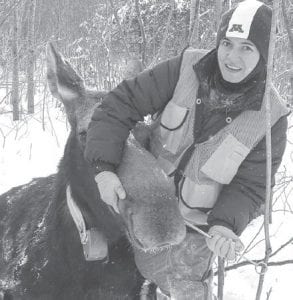Larissa Minicucci, assistant professor at the University of Minnesota College of Veterinary Medicine, uses a special tool to place a mortality implant transmitter into this moose’s digestive tract, as part of a six-year mortality study of the moose in northeastern Minnesota. The transmitters are working—the researchers have learned of five deaths in the first month of the study.

So far five of the 111 radio-collared moose have died in the first month of an intensive sixyear study being conducted by wildlife specialists to determine what is causing the high moose mortality rate in northeastern Minnesota.
“To date we have had five mortalities,” said Erika Butler, D.V.M. Wildlife Veterinarian of the Minnesota Department of Natural Resources (DNR), which is working with a number of partners on the project.
But of these mortalities, Butler said, “Four of these are considered capture-related as they occurred within two weeks of capture. This is a mortality rate of 3.6 percent, which is within the expected range, especially given the poor condition of many of these animals. “The fifth was actually outside our window for capture-related mortalities and was a wolf kill,” Butler said.
Although moose have been radio-collared in the past, these new collars are outfitted with GPS tracking devices and will send researchers six locations of each moose each day, as well as the ambient outside air temperature. If a moose doesn’t move for six hours researchers will text its location every 30 minutes for the next six hours so DNR staff can track the animal.
The goal is to locate moose that have died within 24 hours so they can be brought back and studied to determine what caused their death. If the moose is too big or too far away to retrieve a necropsy will be conducted in the field.
While moose have all but disappeared in northwestern Minnesota, northeastern Minnesota has been the last stand for these magnificent creatures in the Land of 10,000 Lakes.
Last January an aerial survey estimated there were 4,230 moose in northeastern Minnesota. This January the population was estimated to be 2,760, a staggering drop of 35 percent.
Based on that count the DNR cancelled the bulls-only moose-hunting season for 2013.
To further illustrate the decline, in 2006 the aerial survey estimated 8,840 moose were living in Cook, Lake and St. Louis counties.
In spring, after calving the DNR will locate radio-collared cows that have given birth and collar as many as 50 baby moose. These babies will be tracked to determine calf mortality and survival rates, Butler said.
Partners in the project include the Grand Portage Band of Lake Superior Chippewa, Fond Du Lac Band of Lake Superior Chippewa, 1854 Treaty Authority, the University of Minnesota Duluth and the University of Minnesota’s veterinary and wildlife departments.
Butler said the goal of the project is to determine why moose are dying and then to use that information to help make the best wildlife management decisions to help save the moose, it that’s possible.
The $1.6 million study is being funded by the state’s Environmental and Natural Resources Trust Fund.


Loading Comments